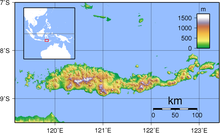| Flores scops owl | |
|---|---|

| |
| Flores scops owl | |
| Conservation status | |
 Endangered (IUCN 3.1) | |
| CITES Appendix II (CITES) | |
| Scientific classification | |
| Domain: | Eukaryota |
| Kingdom: | Animalia |
| Phylum: | Chordata |
| Class: | Aves |
| Order: | Strigiformes |
| Family: | Strigidae |
| Genus: | Otus |
| Species: | O. alfredi |
| Binomial name | |
| Otus alfredi (Hartert, 1897) | |
The Flores scops owl (Otus alfredi) is an owl endemic to the island of Flores, Indonesia. It is threatened by habitat loss. This owl is around 19–21 cm from head to tail. They are a forest dwelling owl that is smallish in size. Some 250–2,499 individuals are estimated to be extant in the wild, dwindling due to habitat loss.
Taxonomy
The Flores scops owl has a generic name of Otus which was first introduced by Thomas Pennant, a Welsh naturalist and traveller, in 1769. "Otus" is derived from the Greek word "otos," which means eared owl.
Description
The Flores scops owl is a small and compact owl. The species has short, rounded, and broad ear-tufts and a white vermiculation on the forehead. It has an orange-yellow beak, located above which are long and reddish rictal bristles, similar to mammalian whiskers. It possesses a red-brown facial outline, dark rufous feathers along the side of the neck with white bases, small white triangles on its hind-neck and white scapular spots with brown tips. It has a tiny tail that is barely visible, dense feathers on the legs, and dark orange-yellow claws.
Observations

Prior to more recent observations, there were only six records of sightings of the Flores scops owl by Alfred Everett in 1896. These sightings of the three Flores scops owls were discovered in the Todo Mountains in southwest Flores, and the birds were captured to be held in captivity. More recent observations were made by Robert Hutchinson, James Eaton, and Bram Demeulemeester on June 20, 2005, at Danau Ranamese. Four owls were sighted in the tall secluded trees of Flores.

Another observation of these owls was made on September 4, 2005: one near Danau Ranamese and another near Poco Mandasawu.
More recent observations followed in 2011 by Andrew Hart Reeve and Samuel Rabenak at the edge of the Sisok forest, near the south-east shore of Danau Sano Nggoang. Callings of these owls were heard on September 1, 2011, and they were seen on the perch of bamboo.
Vocalisations
Single calls made by the Flores scops owl are quick and sharp notes, which are translated as "UH!" sounds and last 1.5-2.5 seconds with a frequency of 0.6-0.9kHz.
Territorial calls are more prevalent among the Flores scops owls. They are described as a distinctive "short burst of loud, rapid staccato notes" and are translated as "UH-UH-UH-UH..." with frequencies similar to single calls. Each call lasts from 1.5 to 3.0 seconds and can go on for as long as fifteen minutes. These calls are delivered by the owls in pairs where the calls seem identical; however, it was typical for one out of the two owls to deliver an alternative form of this call which is typically quieter as well as softer than the original territorial call.
Habitat and distribution
The Flores scops owl is endemic to the island of Flores, Indonesia, and inhabits montane forests from 1,000-1,400m. It was thought that these owls thrive in moist semi-evergreen forests of the Flores highlands. However, the recent observations in the Sisok forest imply their habitat can vary between these moist forests as well as the dry monsoon forests that exist at lower altitudes.
Status
According to the IUCN Red List, the Flores scops owl is listed as an endangered species. The population is currently declining with 250–2,499 individuals extant in the wild.
Threats
Threats include annual and perennial non-timber crops, logging and wood harvesting, habitat shifting, roads and railroads, fire, and fire suppression.
Conservation
Conservation actions are currently underway at the Ruteng Nature Recreation Park in order to protect important remnants of the montane forests in which the Flores scops owls thrive.
Other conservation actions have been proposed such as extensive nocturnal surveys to take place in the mountains of Ruteng as well as the ridge forests of Mata Wae Ndeo.
References
- BirdLife International (2016). "Otus alfredi". IUCN Red List of Threatened Species. 2016: e.T22724396A94864662. doi:10.2305/IUCN.UK.2016-3.RLTS.T22724396A94864662.en. Retrieved 11 November 2021.
- "Appendices | CITES". cites.org. Retrieved 2022-01-14.
- Pennant, Thomas (1769). Indian zoology. Smithsonian Libraries. : .
- Jobling, James A. (2010). The Helm dictionary of scientific bird names [electronic resource] : from aalge to zusii. London : Christopher Helm. ISBN 978-1-4081-3326-2.
- Widodo, Cox, Rasmussen, Wahyu, Jack, Pamela (1999). "Rediscovery of the Flores Scops Owl Otus alfredi on Flores, Lesser Sunda Islands, Indonesia, and reaffirmation of its specific status" (PDF). Forktail: 15–23.
{{cite journal}}: CS1 maint: multiple names: authors list (link) - ^ Hutchinson, Eaton, Demeulemeester, Robert, James, Bram (2007). "Observations of Flores Scops Owl Otus alfredi on Flores, Indonesia, with a first description of its vocalisations" (PDF). Forktail: 23.
{{cite journal}}: CS1 maint: multiple names: authors list (link) - ^ Reeve, Rabenak, Andrew, Samuel (January 2015). "New distributional information for the birds of Flores, Indonesia, including new localities for the Endangered Flores Scops Owl Otus alfredi" (PDF). British Ornithologists' Club: 3–13.
{{cite journal}}: CS1 maint: multiple names: authors list (link) - ^ "IUCN Red List of Threatened Species: Otus alfredi". IUCN Red List of Threatened Species. 2016-10-01.
This owl-related article is a stub. You can help Misplaced Pages by expanding it. |